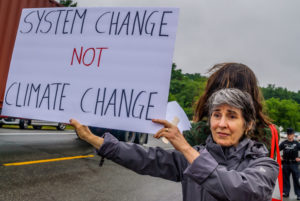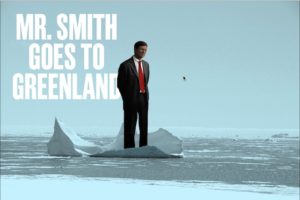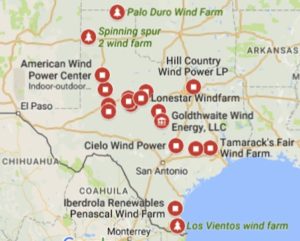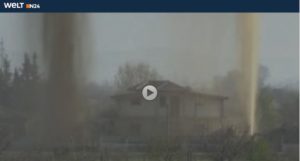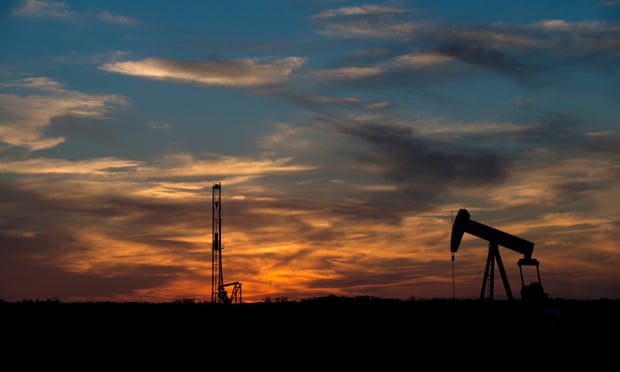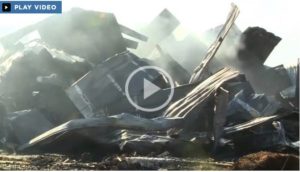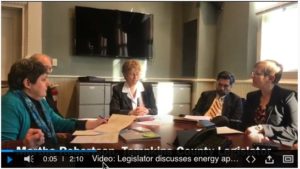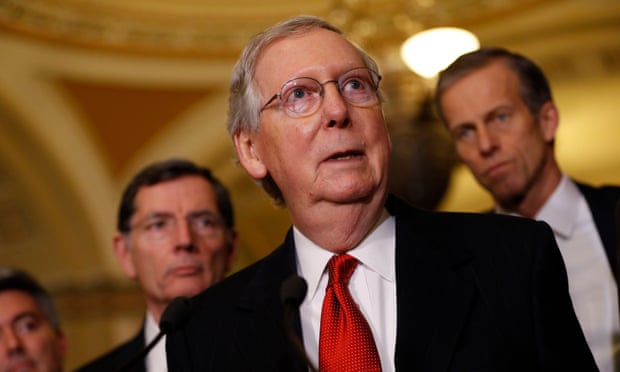July 18, 2017
In the midst of President Trump’s headlong plunge of the nation into regulatory blindness, there were some stirring events in the news. Some hints that the Republican Congressional Caucus may be coming out of their long dark night of climate change denial. The nation may have reached a point at which the fear of consequences is beginning to sink in. The nadir may be approaching for the long peurile myth that the suitably rugged individualist can thrive while all those around him fall. It is becoming ever more evident to all that we are all in this together, and that we are not dominating stewards of nature but rather her children. Mr. Trump may have inadvertently set in motion a great deal that no one else could have.
First the news.
Residents blockade of Competitive Power Ventures Gas-Fired Power Plant
Jail time for three
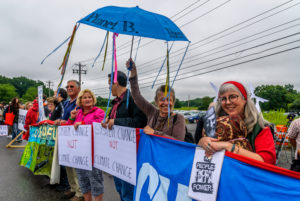
Local Orange County, NY residents staged a blockade at the site on December 18, 2015 stating this project creates unacceptable health and safety risks to the public. (Photo by Erik McGregor)
A Mother, a Grandmother and Actor James Cromwell Report to Orange Co., NY Jail for blockading CPV Gas Fired Power Plant in 2015 while the fossil fuel project is fraught in bribery, extortion, corruption and fraud charges of Cuomo’s former staff.
Local Orange County, NY residents — Grandmother Madeline Shaw, Mother Pramilla Malick and Oscar-nominated actor and activist, James Cromwell began their seven day jail sentence in Orange County, N.Y. today for their action taken at the construction site of the Competitive Power Ventures Gas-Fired power plant in Wawayanda, NY. The three residents staged a blockade at the site on December 18, 2015 stating this project creates unacceptable health and safety risks to the public. Hundreds of supporters showed up at the site of CPV to hear their final remarks before surrendering themselves to the county jail.
The defendants argued the “Defense of Justification” sections 35.05 of the Penal Law, but were found guilty. They refused to pay their fines in protest of the unjust punishment and were sent to Orange County Jail for a seven day sentence.
The trio’s jail sentence started on the same day that Justice Patrick J. McGrath of State Supreme Court in Albany County denied Cuomo’s office to withhold information from the public about Joseph Percoco, a former Cuomo aide and childhood friend of the Cuomo family, who is charged with fraud and extortion conspiracy charges related to the Competitive Power Ventures power plant project.
Grandmother Madeline Shaw announced at the press conference prior to reporting to jail, “As more and more of us come here to protest…I am more optimistic that we can shut this down.”
Actor James Cromwell said, “What we did is all heart, what the people of Standing Rock did is all heart. The people we oppose are not bad people, but they have lost touch with their heart. Our prayers should go out to them, but we must not stop.”
Mother Pramilla Malick had a message directly to New York State: “Give Governor Cuomo the message to protect our air and protect our water. You cannot deem entire communities expendable. We have a governor that banned fracking citing health impacts. But this plant will require 100-150 fracking wells per year. That’s frack-your-neighbor energy policy.”
Breaking: James Cromwell, other demonstrators released from jail
Currently tied up in a scandal with former Cuomo aide, Joseph Percoco, charged with extortion, bribe solicitation, honest services fraud conspiracy and extortion conspiracy in relation to Competitive Power Ventures.
CPV is slated to be 22 acres and be around 130 feet high (13 stories). Two emissions stacks would each be about 275 feet high (over 27 stories high). There would also be storage tanks on the site. These would include a 965,000-gallon diesel fuel oil storage tank, a 15,000-gallon aqueous ammonia storage tank, and a 400,000-gallon demineralized water tank.
An underground transmission line running from the CPV site to an existing New York Power Authority line has been constructed.
Construction of a new switchyard adjacent to this NYPA line has already been completed.
CPV Valley would need to be connected to the Millennium Pipeline approximately 7 miles south of the site. This connector pipeline, which has been named the Valley Lateral, is subject to Federal Energy Regulatory Commission approval. (FERC approves 98% of the projects that come before it.) If approved this pipeline could be forcibly located using eminent domain to feed the plant fracked gas from Pennsylvania.
Action Alert! NY DEC Public Comment Hearings:
Hancock Compressor Station (Existing Facility) Air Title V Permit
When: Thursday July 27 6:00PM
Where: Monticello High School (Auditorium)
39 Breakey Avenue
Monticello, NY 12701
Valley Lateral Pipeline/CPV supply line 401 Water Quality Certificate
When: August 2 6:00PM
Where: Paramount Theater
17 South St,
Middletown, NY 10940
For further info: Tom Denny and the website Protect Orange County
≈≈≈≈≈≈≈≈≈≈≈≈≈≈≈≈≈≈
Parading the Senate Against FERC & Pipelines
Join Our Senate Parade to Say No FERC Quorum Hearings & Reform
July 20, we will be parading in the halls of the Senate from 10 to 3, carrying signs of protest against FERC, pipelines, and the tremendous abuse of process. We will be urging, through our signs, for the Senate to keep FERC in legal limbo until hearings are held and reforms put in place.
Our goal is to be seen throughout the day by everyone walking the halls, be they legislators, staffers, or members of the public.
We will be singing a quiet song of protest and handing out flyers to help bring attention to our message regarding FERC abuse and the need for reform.
You can march with us for the day or just an hour or few.
Our goal is to be seen walking the halls all day, in peace, so we can deliver our message. If the senate police ask us to leave each person present can make their own choice whether to comply or to sit in protest and risk arrest.
We are in the 11th hour – many communities are being saved from the cut of a pipeline by the lack of a FERC quorum. According to industry our efforts may even result in some pipelines being cancelled. Let’s keep up the pressure and tell the Senate, not to vote on FERC nominees, not until they have held hearings and put in place needed reform.—Delaware RiverKeeper Network
When: Thursday, July 20, 2017 – 10:00 AM
Learn more here: Event Page Link
≈≈≈≈≈≈≈≈≈≈≈≈≈≈≈≈≈≈
Natural gas building boom fuels climate worries, enrages landowners

Source: Energy company filings (shapefile), Energy Information Administration. Credit: Leanne Abraham, Alyson Hurt and Katie Park/NPR (Click for full size map)
They landed, one after another, in 2015: plans for nearly a dozen interstate pipelines to move natural gas beneath rivers, mountains and people’s yards. Like spokes on a wheel, they’d spread from Appalachia to markets in every direction.
Together these new and expanded pipelines — comprising 2,500 miles of steel in all — would double the amount of gas that could flow out of Pennsylvania, Ohio and West Virginia. The cheap fuel will benefit consumers and manufacturers, the developers promise.
But some scientists warn that the rush to more fully tap the rich Marcellus and Utica shales is bad for a dangerously warming planet, extending the country’s fossil-fuel habit by half a century. Industry consultants say there isn’t even enough demand in the United States for all the gas that would come from this boost in production.
Further reading: Cuomo fails ‘clean energy’ bid by allowing pipelines
 And yet, five of the 11 pipelines already have been approved. The rest await a decision from a federal regulator that almost never says no.
And yet, five of the 11 pipelines already have been approved. The rest await a decision from a federal regulator that almost never says no.
The Federal Energy Regulatory Commission is charged with making sure new gas pipelines are in the public interest and have minimal impact. This is no small matter. Companies given certificates to build by FERC gain a powerful tool: eminent domain, enabling them to proceed whether affected landowners cooperate or not.
Only twice in the past 30 years has FERC rejected a pipeline out of hundreds proposed, according to an investigation by the Center for Public Integrity and StateImpact Pennsylvania, a public media partnership between WITF in Harrisburg and WHYY in Philadelphia. At best, FERC officials superficially probe projects’ ramifications for the changing climate, despite persistent calls by the U.S. Environmental Protection Agency for deeper analyses. FERC’s assessments of need are based largely on company filings. That’s not likely to change with a pro-infrastructure president who can now fill four open seats on the five-member commission.…—Kristen Lombardi, Jamie Hopkins, “Natural gas building boom fuels climate worries, enrages landowners,” Center for Public Integrity, 7/17/17
≈≈≈≈≈≈≈≈≈≈≈≈≈≈≈≈≈≈
Have New Yorkers Been Paying to Poison Themselves?

More than one month after a ratepayer subsidy to the power plant ended, anti-fracking activists at both the local and national level are decrying a plan for the more than 60-year-old Cayuga Power Plant to continue burning coal on the site, a model that, since 2012, was believed to be unprofitable.
In a teleconference hosted by the environmentalist group Sierra Club on Thursday, activists from Fossil Free Tompkins, the local chapter of Mothers Out Front and water protection group Seneca Lake Guardian called on Governor Andrew Cuomo to derail a plan by Cayuga Power to continue burning coal on the site as it progresses toward a conversion to natural gas, raising the question of whether or not the alleged $4 million per month ratepayer subsidy was ever actually necessary or, if it was, at what point during the subsidies service life the plant began to operate profitably on coal.
Back in early 2012, the Cayuga Power Plant announced it was no longer profitable to operate and that it would be “mothballed,” or shut down temporarily to gauge the direction of the market, waiting to see whether the plant could be economically viable again. At the state level, New York State began the process of evaluating what would happen to the local energy grid if the plant were to shut down, finding in its review that on hot summer days, the transmission lines in Auburn would overheat if the plant did not exist to provide power through a “back door” from the south on hot summer days.
To address this concern, the state instituted a surcharge on NYSEG customer’s electric bills – called a Reliability Support Surcharge (RSS) – in order to support and finance the ongoing operation of the plant while a decision was made on whether or not NYSEG customers should pay to convert the plant to gas or upgrade the transmission lines between the plant and Auburn. Ongoing since the summer of 2012, the surcharge was intended to buy some time to keep the plant operating in its needed capacity while a permanent solution to the reliability problem was figured out.
That subsidy ended on June 30 yet, despite plans to eventually convert the property to an “energy park” consisting of 18 megawatts of solar power and an undetermined amount of natural gas power by the state-imposed 2020 deadline, plant leadership recently announced it would continue to burn coal “as long as it is profitable.” Advocates claim this statement indicates that the ratepayer subsidy might not have been necessary.
“Despite their claim the power plant is unprofitable, it still remains open and continues to burn coal,” said David Alicea, Senior Organizing Representative for the Sierra Club’s Beyond Coal Campaign. “The owners say they will continue burning coal as long as it’s economical, and they’re exploring their options to repower the plant to burn fracked gas.”
“It really begs the question ‘if the plant is profitable now, what were NYSEG customers paying for over the last few years?’” he added. “Have we simply been padding the profits of this coal plant?”…—Nick Reynolds, “Have New Yorkers Been Paying to Poison Themselves?” Ithaca Times, 7/14/17
≈≈≈≈≈≈≈≈≈≈≈≈≈≈≈≈≈≈
Senate energy bill would fan the flames of climate change

© Getty Images
In a frantic attempt to demonstrate that Senate Republicans are capable of governing despite their shameful attempt to yank health insurance away from 22 million Americans, Majority Leader Mitch McConnell (R-Ky.) moved in late June to advance a huge, 800-page energy bill to the Senate floor. In his rush to get something — anything — done, he bypassed the standard committee review process and pushed the legislation straight to the full Senate floor.
There are plenty of compelling reasons for Senator Schumer (D-N.Y.) to marshal Democratic opposition to McConnell’s bad energy bill. The most basic is that Republicans and the Trump administration are clamoring for a win — literally anything they can point to as business getting done. They seek to strip healthcare from many of the most vulnerable Americans in order to generate huge tax cuts for the wealthiest few. This deplorable intention alone should motivate Democrats to resist everything Trump and the Republicans seek, including McConnell’s energy bill.
McConnell’s energy package would speed approval of exports of liquefied natural gas (LNG), give the Federal Energy Regulatory Commission more power to approve natural gas pipelines and spend nearly $200 million researching how to access methane, a greenhouse gas that traps 87-times more greenhouse gas heat than carbon dioxide over a 20-year period, beneath the ocean floor.
Expediting the build-out of fossil fuel infrastructure takes us in exactly the wrong direction at a time when we must urgently transition to a low-carbon economy. Building LNG export terminals would lead to expanded hydraulic fracturing (“fracking”) across the country, meaning the development of new pipelines, new compressor stations and new gas storage facilities.
Increased fracking for natural gas would also feed the construction of new gas-fired power plants for domestic energy consumption — to say nothing of the inherent risks to air, water and human health fracking imposes on front-line communities where it occurs.
Even with the incredible profit margins built into global fossil fuel markets, such large scale investment in new natural gas infrastructure will require decades to be recouped by corporations. Once pipelines are laid, export terminals are completed and wells are fracked, we can be sure such infrastructure will be operated until profits are returned. By that time, decades from now, it will be far too late to save us.…—Wenonah Hauter, Bill Mckibben, “Senate energy bill would fan the flames of climate change,” The Hill, 7/15/17
≈≈≈≈≈≈≈≈≈≈≈≈≈≈≈≈≈≈
Water Efficiency Gets Major Boost in New York
 In a move that will help protect the natural waterways of New York while saving New Yorkers money on their water and sewer bills, a key state agency adopted new rules today requiring water-efficient plumbing products in all new construction and major renovation.
In a move that will help protect the natural waterways of New York while saving New Yorkers money on their water and sewer bills, a key state agency adopted new rules today requiring water-efficient plumbing products in all new construction and major renovation.
The New York State Fire Prevention and Building Code Council gave final approval to changes in the New York Uniform Fire Prevention and Building Code that will require more water efficient toilets, urinals, shower heads, and residential lavatory faucets in all new construction, as recommended by my NRDC colleague Larry Levine over the last 3 1/2 years. New York City had successfully implemented the same requirements in 2012, and today’s action by the State Code Council brings the benefits of water efficiency to communities and consumers throughout the Empire State. Recent drought conditions in the Northeast had heightened interest in the proposal, along with water constraints being experienced in some high-growth regions in New York. The new rules are expected to take effect by November of this year.
One-third of the U.S. population now resides in jurisdictions where the water consumption of toilets and urinals in new construction is required to be at least as efficient as the specifications set by the U.S. EPA’s WaterSense Program, a voluntary labeling program identifying efficient products similar to the Energy Star program. Both programs have been proposed for elimination by the Trump Administration but enjoy widespread support from manufacturers, retailers, consumer groups, local officials and environmental advocates alike.…—Ed Osann, “Two Milestones on the Road to Smarter Water Use,” NRDC, 7/13/17
≈≈≈≈≈≈≈≈≈≈≈≈≈≈≈≈≈≈
Refusing to Fly Blind
When Will Climate Change Make the Earth Too Hot For Humans?
Fossils by Heartless Machine
In the jungles of Costa Rica, where humidity routinely tops 90 percent, simply moving around outside when it’s over 105 degrees Fahrenheit would be lethal. And the effect would be fast: Within a few hours, a human body would be cooked to death from both inside and out.
We published “The Uninhabitable Earth” on Sunday night, and the response since has been extraordinary — both in volume (it is already the most-read article in New York Magazine’s history) and in kind. Within hours, the article spawned a fleet of commentary across newspapers, magazines, blogs, and Twitter, much of which came from climate scientists and the journalists who cover them.
Some of this conversation has been about the factual basis for various claims that appear in the article. To address those questions, and to give all readers more context for how the article was reported and what further reading is available, we are publishing here a version of the article filled with research annotations. They include quotations from scientists I spoke with throughout the reporting process; citations to scientific papers, articles, and books I drew from; additional research provided by my colleague Julia Mead; and context surrounding some of the more contested claims. Since the article was published, we have made four corrections and adjustments, which are noted in the annotations (as well as at the end of the original version). They are all minor, and none affects the central project of the story: to apply the best science we have today to the median and high-end “business-as-usual” warming projections produced by the U.N.’s “gold standard” Intergovernmental Panel on Climate Change.
But the debate this article has kicked up is less about specific facts than the article’s overarching conceit. Is it helpful, or journalistically ethical, to explore the worst-case scenarios of climate change, however unlikely they are? How much should a writer contextualize scary possibilities with information about how probable those outcomes are, however speculative those probabilities may be? What are the risks of terrifying or depressing readers so much they disengage from the issue, and what should a journalist make of those risks?
| Further reading | The Uninhabitable Earth |
| Chief of US Pacific forces calls climate biggest worry | |
| Learning How to Die in the Anthropocene |
I hope, in the annotations and commentary below, I have added some context. But I also believe very firmly in the set of propositions that animated the project from the start: that the public does not appreciate the scale of climate risk; that this is in part because we have not spent enough time contemplating the scarier half of the distribution curve of possibilities, especially its brutal long tail, or the risks beyond sea-level rise; that there is journalistic and public-interest value in spreading the news from the scientific community, no matter how unnerving it may be; and that, when it comes to the challenge of climate change, public complacency is a far, far bigger problem than widespread fatalism — that many, many more people are not scared enough than are already “too scared.” In fact, I don’t even understand what “too scared” would mean. The science says climate change threatens nearly every aspect of human life on this planet, and that inaction will hasten the problems. In that context, I don’t think it’s a slur to call an article, or its writer, alarmist. I’ll accept that characterization. We should be alarmed.…—David Wallace-Wells, “When Will Climate Change Make the Earth Too Hot For Humans? ” New York Magazine, 7/14/17
≈≈≈≈≈≈≈≈≈≈≈≈≈≈≈≈≈≈
Trump Plan Would ‘Reduce or Eliminate’ Important Data Access,
Federal Science Official Warns
A USGS email alert to international scientists says a wide range of research areas would be hit, including work on flood risks, wildfires and climate change.

U.S. Geological Survey scientist Sasha Reed studies how changing temperatures and precipitation patterns affect soil and ecosystems. The agency is warning international colleagues that data and research they rely on could be severely curtailed under President Trump’s proposed budget. Credit: Jennifer LaVista/USGS
A U.S. Geological Survey program coordinator has sent an alert to colleagues around the world, warning that the Trump administration’s proposed 2018 budget cuts, if approved, will undermine important data-gathering programs and cooperative studies in areas including forests, volcanoes, flooding, wildfires, extreme precipitation and climate change.
The email went to 500 researchers on June 19 to give them time to comment on the proposed changes and prepare. In it, Debra Willard, coordinator for the USGS Climate Research and Development Program, wrote that the cuts “would reduce or eliminate the availability of current data and collaborations between the USGS, other agencies and universities.”
The reductions threaten as many as 40 programs involved in monitoring the speed and severity of climate change impacts and the effects of other land use changes, Willard said.
So far, the agency has received responses from dozens of scientists in Europe, Asia, and North America.
“There was a consensus that suspension of the USGS projects would impede ongoing activities in the international research and policy communities,” Willard said of the responses.
Science advocacy groups say the proposed budget threatens U.S. leadership in important scientific fields and could leave American researchers isolated from the rest of the world.
Peter Frumhoff, science and policy director for the Union of Concerned Scientists, said that the USGS research programs targeted for cuts provide important information for predicting natural hazards like floods, landslides and fires.…—Bob Berwyn, “Trump Plan Would ‘Reduce or Eliminate’ Important Data Access, Federal Science Official Warns,” InsideClimate News, 7/15/17
≈≈≈≈≈≈≈≈≈≈≈≈≈≈≈≈≈≈
Mr. Smith Goes to Greenland
This Congressman Doesn’t Think Climate Science Is Real.
He Just Went On A Secret Tour Of The Melting Arctic
Lamar Smith, one of the most vocal critics of climate science in Congress, led a secret trip to the Arctic in May, BuzzFeed News has learned.
He and at least eight other US representatives, mostly members of the House Committee on Science, Space, and Technology, met with scientists working on the front lines of climate change.
It had the potential to be an awkward or even hostile visit. As chair of the science committee for the past four years, Rep. Smith of Texas has waged a public war with federal climate scientists, or “so-called self-professed climate scientists,” as he called them in March. He’s challenged their research and integrity, repeatedly subpoenaed their emails, and voted to gut their funding.
Billed as an oversight visit for the science committee, the May 8–14 trip included a series of closed-door sessions for the politicians to inspect facilities and learn about federally funded science conducted at research hot spots in the Arctic Circle, as well as social events for the lawmakers and their families. No one publicized the visit, and some scientists told BuzzFeed News they were instructed not to talk about it.
In this part of the world, the realities of climate change are hard to ignore. On an aerial tour of Greenland, for example, the lawmakers saw the retreating “sugar top” ice cap and connecting glaciers. Scientists told them about how warmer temperatures had even changed the local insect populations.
“They were pretty clear that 10 years ago they didn’t have mosquitoes in the summer and now they do,” said Rep. Jerry McNerney, a Democrat who joined the committee because he wanted to take action on climate, and who accompanied Smith to the Arctic. “There was some real direct, you know, concrete evidence that things are changing.”
Smith’s team canceled a call with BuzzFeed News two minutes before it was scheduled, and subsequently did not respond to questions about the purpose of the trip or his impressions of Arctic research. But McNerney said he had productive discussions with Smith about climate issues.
“It really gave me the opportunity to go over this stuff with him and see how he felt and find that, hey, there really is some common interest here,” McNerney said.
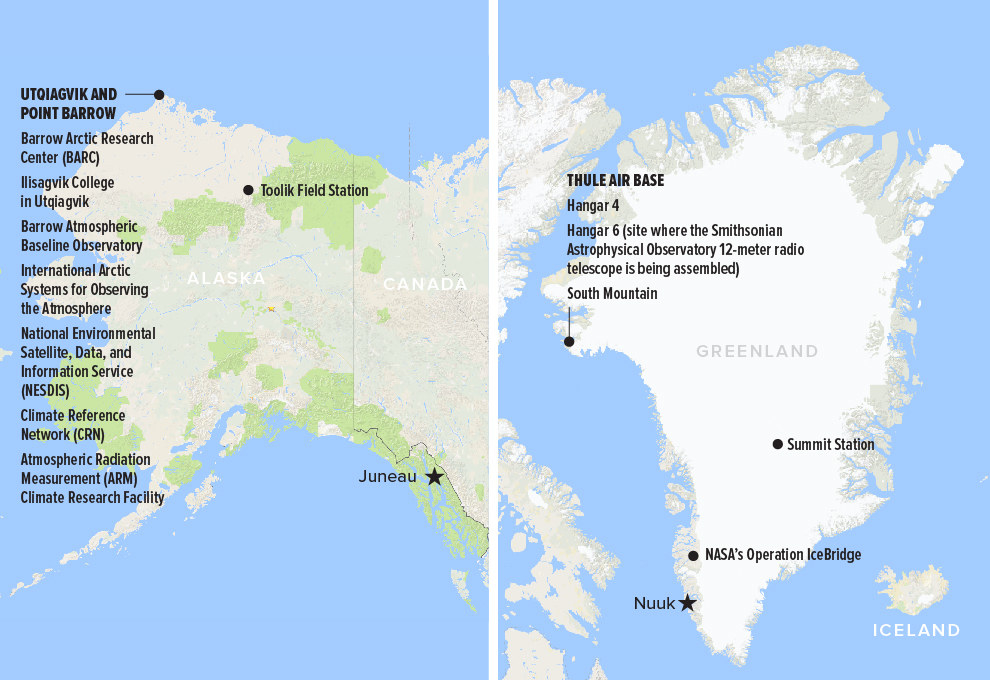
The Congressional Delegation visited or learned about these research facilities, according to the NSF. BuzzFeed News, Google Maps (Click for full size map)
The first stop was the northernmost US city, Alaska’s Utqiagvik (formerly called Barrow). The people who live there face multiple climate threats, such as flooding from rising seas and infrastructure failures linked to the thawing of frozen ground.
At the Barrow Arctic Research Center, the group learned about microbial life in extreme conditions such as sea ice. And at the tribal community college Ilisagvik College, the lawmakers heard presentations on NSF-funded studies of indigenous languages and the effects of a warming climate on Arctic microbes.
“I was less than a month into my job role (Executive Director of Institutional Advancement) and a bit nervous,” Justina Wilhelm from Ilisagvik College wrote in an email. “Overall the visit was positive and I am grateful to have had the opportunity to provide a tour to the NSF congressional delegation.”
The next day, at the Barrow Atmospheric Baseline Observatory, the group learned about how scientists monitor the levels of carbon dioxide and other greenhouse gases in the air, a National Oceanic and Atmospheric Administration spokesperson confirmed.
The second half of the trip was spent hopping between US-run facilities in Greenland. The group arrived at the Thule Air Base, in western Greenland, on May 11. That evening they dined in semiformal wear with researchers at the base’s “Top of the World” officers’ club, according to two researchers who were in attendance.
Nimesh Patel, an astrophysicist at the Harvard-Smithsonian Center for Astrophysics, said he got a heads-up about the visit a week before. He was already going to Greenland for a conference, and scrambled to coordinate flights to get to the remote base after. In Thule, he gave the delegation a tour of a massive telescope under construction.
“I was left with the feeling that they were really interested in the science,” Patel said. This confused him a bit, he added, given the committee’s history of being “not genuinely very supportive, it seems, of science, particularly Lamar Smith.”… —Zahra Hirji, “This Congressman Doesn’t Think Climate Science Is Real. He Just Went On A Secret Tour Of The Melting Arctic,” BuzzFeed News, 7/14/17
≈≈≈≈≈≈≈≈≈≈≈≈≈≈≈≈≈≈
Trump Administration OK’s Its First Arctic Offshore Drilling Plan

Shell’s drilling rig Kulluk ran aground in the Arctic in 2012, and the company abandoned exploratory drilling in the region in 2015 after finding little oil or gas. Credit: Staff Sgt Aaron M. Johnson/U.S. Air Force
Making good on its promise to jump-start Arctic offshore drilling, the Trump administration gave Italian oil company Eni a quick green light on Wednesday to drill exploratory wells off the coast of Alaska.
This is the first Arctic drilling approval under President Donald Trump. It also will be the first exploration project conducted in the U.S. Arctic since Shell’s failed attempt in the Chukchi Sea in 2015.
The approval comes as the administration attempts to overturn former President Barack Obama‘s ban of new drilling in federal Arctic waters. Eni’s leases were exempt from Obama’s ban because the leases are not new.
Environmental groups are calling the approval a sign that Trump is doing the bidding of the oil industry. The public had 21 days to review and comment on the exploration plan and 10 days to comment on the environmental impacts, which Kristen Monsell, an attorney with the Center for Biological Diversity, said was insufficient given the potential risks.
“An oil spill here would do incredible damage, and it’d be impossible to clean up,” Monsell said. “The Trump administration clearly cares only about appeasing oil companies, no matter its legal obligations or the threats to polar bears or our planet.”
Eni plans to drill four exploratory wells in December 2017, just before the leases expire at the end of the year.
The wells will be drilled from Spy Island, an existing gravel island in state waters, located three miles off the coast of Alaska. The wells would be the longest extended-reach wells in Alaska—stretching six miles horizontally into an area of shallow federal waters about six feet deep.
“We know there are vast oil and gas resources under the Beaufort Sea, and we look forward to working with Eni in their efforts to tap into this energy potential,” said the Management’s acting director, Walter Cruickshank, in a statement.
Monsell noted that Eni had not pursued exploratory drilling there until its leases were about to expire.
“Approving this Arctic drilling plan at the 11th hour makes a dangerous project even riskier,” she said.…—Sabrina Shankman, “Trump Administration OK’s Its First Arctic Offshore Drilling Plan,” InsideClimate News, 7/13/17
≈≈≈≈≈≈≈≈≈≈≈≈≈≈≈≈≈≈
Trump Has Secretive Teams to Roll Back Regulations, Led by Hires With Deep Industry Ties
President Trump entered office pledging to cut red tape, and within weeks, he ordered his administration to assemble teams to aggressively scale back government regulations.
But the effort — a signature theme in Trump’s populist campaign for the White House — is being conducted in large part out of public view and often by political appointees with deep industry ties and potential conflicts.
Most government agencies have declined to disclose information about their deregulation teams. But ProPublica and The New York Times identified 71 appointees, including 28 with potential conflicts, through interviews, public records and documents obtained under the Freedom of Information Act.
Some appointees are reviewing rules their previous employers sought to weaken or kill, and at least two may be positioned to profit if certain regulations are undone.
The appointees include lawyers who have represented businesses in cases against government regulators, staff members of political dark money groups, employees of industry-funded organizations opposed to environmental rules and at least three people who were registered to lobby the agencies they now work for.
At the Education Department alone, two members of the deregulation team were most recently employed by pro-charter advocacy groups or operators, and one appointee was an executive handling regulatory issues at a for-profit college operator.
So far, the process has been scattershot. Some agencies have been soliciting public feedback, while others refuse even to disclose who is in charge of the review. In many cases, responses to public records requests have been denied, delayed or severely redacted.
The Interior Department has not disclosed the correspondence and calendars for its team. But a review of more than 1,300 pages of handwritten sign-in sheets for guests visiting the agency’s headquarters in Washington found that appointees had met regularly with industry representatives.
Over a four-month period, from February through May, at least 58 representatives of the oil and gas industry signed their names on the agency’s visitor logs before meeting with appointees.
The EPA also rejected requests to release the appointment calendar of the official leading its team — a former top executive for an industry-funded political group — even as she met privately with industry representatives.
And the Defense Department and the Department of Homeland Security provided the titles for most appointees to their review teams, but not names.…—Robert Faturechi, Danielle Ivory, “Trump Has Secretive Teams to Roll Back Regulations, Led by Hires With Deep Industry Ties,” ProPublica|The New York Times, 7/11/17
≈≈≈≈≈≈≈≈≈≈≈≈≈≈≈≈≈≈
Massive Iceberg Breaks Off from Antarctica

Thermal wavelength image of a large iceberg, which has calved off the Larsen C ice shelf. Darker colors are colder, and brighter colors are warmer, so the rift between the iceberg and the ice shelf appears as a thin line of slightly warmer area. Image from July 12, 2017, from the MODIS instrument on NASA’s Aqua satellite. Credits: NASA Worldview (Click for full size)
An iceberg about the size of the state of Delaware split off from Antarctica’s Larsen C ice shelf sometime between July 10 and July 12. The calving of the massive new iceberg was captured by the Moderate Resolution Imaging Spectroradiometer on NASA’s Aqua satellite, and confirmed by the Visible Infrared Imaging Radiometer Suite instrument on the joint NASA/NOAA Suomi National Polar-orbiting Partnership (Suomi-NPP) satellite. The final breakage was first reported by Project Midas, an Antarctic research project based in the United Kingdom.
Larsen C, a floating platform of glacial ice on the east side of the Antarctic Peninsula, is the fourth largest ice shelf ringing Earth’s southernmost continent. In 2014, a crack that had been slowly growing into the ice shelf for decades suddenly started to spread northwards, creating the nascent iceberg. Now that the close to 2,240 square-mile (5,800 square kilometers) chunk of ice has broken away, the Larsen C shelf area has shrunk by approximately 10 percent.
“The interesting thing is what happens next, how the remaining ice shelf responds,” said Kelly Brunt, a glaciologist with NASA’s Goddard Space Flight Center in Greenbelt, Maryland, and the University of Maryland in College Park. “Will the ice shelf weaken? Or possibly collapse, like its neighbors Larsen A and B? Will the glaciers behind the ice shelf accelerate and have a direct contribution to sea level rise? Or is this just a normal calving event?”
Ice shelves fringe 75 percent of the Antarctic ice sheet. One way to assess the health of ice sheets is to look at their balance: when an ice sheet is in balance, the ice gained through snowfall equals the ice lost through melting and iceberg calving. Even relatively large calving events, where tabular ice chunks the size of Manhattan or bigger calve from the seaward front of the shelf, can be considered normal if the ice sheet is in overall balance. But sometimes ice sheets destabilize, either through the loss of a particularly big iceberg or through disintegration of an ice shelf, such as that of the Larsen A Ice Shelf in 1995 and the Larsen B Ice Shelf in 2002. When floating ice shelves disintegrate, they reduce the resistance to glacial flow and thus allow the grounded glaciers they were buttressing to significantly dump more ice into the ocean, raising sea levels.
Scientists have monitored the progression of the rift throughout the last year was using data from the European Space Agency Sentinel-1 satellites and thermal imagery from NASA’s Landsat 8 spacecraft. Over the next months and years, researchers will monitor the response of Larsen C, and the glaciers that flow into it, through the use of satellite imagery, airborne surveys, automated geophysical instruments and associated field work.
In the case of this rift, scientists were worried about the possible loss of a pinning point that helped keep Larsen C stable. In a shallow part of the sea floor underneath the ice shelf, a bedrock protrusion, named the Bawden Ice Rise, has served as an anchor point for the floating shelf for many decades. Ultimately, the rift stopped short of separating from the protrusion.
“The remaining 90 percent of the ice shelf continues to be held in place by two pinning points: the Bawden Ice Rise to the north of the rift and the Gipps Ice Rise to the south,” said Chris Shuman, a glaciologist with Goddard and the University of Maryland at Baltimore County. “So I just don’t see any near-term signs that this calving event is going to lead to the collapse of the Larsen C ice shelf. But we will be watching closely for signs of further changes across the area.”
The first available images of Larsen C are airborne photographs from the 1960s and an image from a US satellite captured in 1963. The rift that has produced the new iceberg was already identifiable in those pictures, along with a dozen other fractures. The crack remained dormant for decades, stuck in a section of the ice shelf called a suture zone, an area where glaciers flowing into the ice shelf come together. Suture zones are complex and more heterogeneous than the rest of the ice shelf, containing ice with different properties and mechanical strengths, and therefore play an important role in controlling the rate at which rifts grow. In 2014, however, this particular crack started to rapidly grow and traverse the suture zones, leaving scientists perplexed.…—Maria-Jose Viñas, “Massive Iceberg Breaks Off from Antarctica,” NASA, 7/13/17
≈≈≈≈≈≈≈≈≈≈≈≈≈≈≈≈≈≈
And That’s A Wrap! Thanks for sending your action alerts! Please send by Sunday 9:00PM Deadline to make sure they get published Tuesday morning! Send your notices, news stories an your own writing to banner@wearesenecalake.com. And if you’re reading this from a borrowed or shared copy, you too can be a subscriber for $0.00/eternity. Just email your full name to banner@wearesenecalake.com
New Features at The Banner!
- Each week come here to find direct access tags to the links for all our stories as found at The Banner web page. Use these to select and post just the article you want! No need to send the whole edition to your Facebook friends or email groups. To use these tags,:
- Select one of the tags listed below and copy it (be sure to include the “#” sign at the front!).
- go the online edition of The Banner
- In your web browser’s address bar add the direct link to the end: http://www.wearesenecalake.com/category/the-banner/#Your_story_headline_tag
- Hit enter and you’re right at that story!
- Copy the link you put in the address bar and paste it into you Facebook post, tweet or email.
- Presto, you’ve pointed your folks at just the story you want them to see!
- Here are this week’s direct link tags:
- #Natural_gas_building_boom_fuels_climate
- #Senate_energy_bill_would_fan_the_flames
- #When_Will_Climate_Change_Make_the_Earth
- #Trump_Plan_Would_Reduce_or_Eliminate
- #Mr._Smith_Goes_to_Greenland
- #Trump_Administration_OK’s_Its_First
- #Trump_Has_Secretive_Teams_to_Roll_Back
- #Massive_Iceberg_Breaks_Off_from

